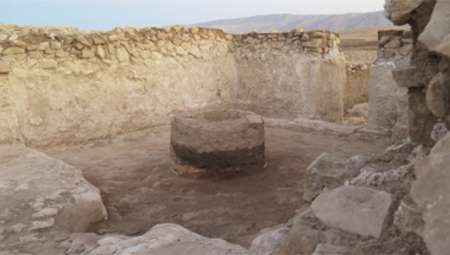
RICHT Public Relations Office quoted supervisor of the exploration program in Jahangir Dome, Leila Khosravi as saying research works of the exploration team in the area of Jahangir Dome in line with the continuation of archeological studies in the Kangir River basin, resulted in the discovery and appearance of architectural spaces and unparalleled plaster works with animal (Pegasus), human and plant motifs.
Referring to the fact that the expanded Jahangir Dome was one of the three areas brought under archeological explorations in the course of the construction of Kangir Dam, Leila Khosravi said with regard to the insufficient archeological research especially on the construction of that type of residential textures and condition of cities and villages of the historic era in west of Iran which continued their lives in the advent of Islam, the necessity and importance of implementation of the program was quite obvious.
The archeologist said that the most important portable findings in the explorations were potteries among which noticeable pottery of the Parthian era in the layers beneath and remarkable pottery of the Sassanid era simultaneously with the construction of the buildings and small amount of Islamic pottery related to the phases for tribal settlement.
She referred to the stone, metal, glass and animal bone and plant remains findings among objects discovered in the explorations and said stone findings included millstone, mortar, weight stone, and grindstone which determine the type of living in the tribal phase for us.
Stressing that the evidence shows that the dome had been built with a prior plan, she said the special position of the area in the central Zagros region and its location on one of the strategically important ancient routes of Mesopotamia and the Kangir River could be one of the effective parameters in the shaping of this settlement in the historic era.
She said gypsum plaster has been the main material for building the walls and half-baked half-beaten plaster has been the basic mortar used in the construction of the building as well as bricks in different sizes, which have been used to cover the ceilings.
According to the archeologist, construction of dome covering with brick and stone, large halls with vault, use of stone and plaster material in the architecture and use of springing arch for covering the roofs of the rooms are the heritage of the Sassanid era, which are seen in this building.
According to Khosravi, the period of prosperity and boom of the area started under the Sassanid’s, because in this period due to the population growth, urbanization and urban development made a dramatic expansion.
The archaeologist noted that the unearthed architectural remains could be divided into two categories: first, the main building which has been built in the Sassanid era over a Parthian precinct area and in the first Islamic century up to the fourth century Hegira had been used by tribes and nomads.
Saying that the area had been used as a winter resort by tribes along the Kangir River, she said explorations and excavations in the building show manipulation of the tribes over the centuries. She noted that primary and simple construction by using materials remained from the ruins of the main building with clay mortar are among those changes.
Leila Khosravi said Jahangir Dome enclosure with a span of over 15 hectares is located on the margin of the Kangir River in Zarneh district of the city of Eivan in Ilam Province.
Referring to the fact that Ilam Province in terms of geographical history in the historical and Islamic eras is divided into the two northern and southern sections, she said the northern part had been called Masbazan with Shirvan or Sirvan as its center and the southern part called Mahrajan Qazaq with Seymareh as its center. The area under exploration is part of the Masbazan region.
She added that in ancient texts reference has been made to three cities of Masbazan including Sirvan, Ariohan and Alraz and the area of Ariohan should be searched in the city of Eivan.
Pointing to Yaqut Hamawi’s reference to Ariohan, she said Henry Rawlinson also believed that the center of Ariohan is the same Zarneh which was known as Ariohan up to the 13th century.
9376**1771
www.irna.ir
 solhkhabar | Peace International News Agency Peace International News Agency , Peace News , International Agency News of Peace
solhkhabar | Peace International News Agency Peace International News Agency , Peace News , International Agency News of Peace